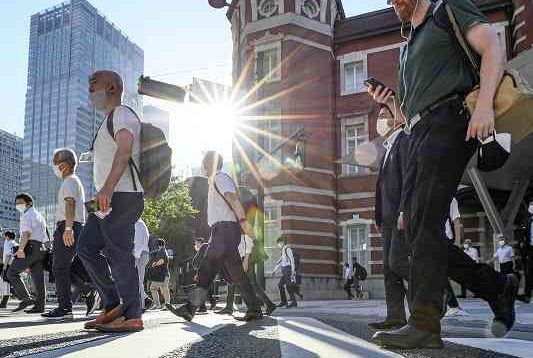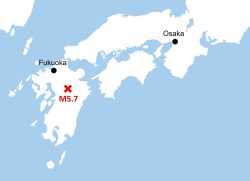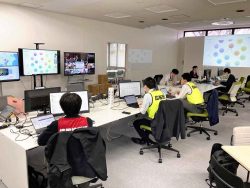
People walk under a strong early morning sun in Chiyoda Ward, Tokyo, on Monday.
6:00 JST, June 30, 2022
As the rainy season comes to an abrupt end this summer in region after region, the “heatstroke alert” system established last year by the Environment Ministry and the Japan Meteorological Agency has already come into play.
The system is aimed at raising awareness of the risks of heat-related illnesses, utilizing the long-established “heat stress index” that is based not only on temperature, but factors such as humidity, exposure to direct sunlight and wind strength.
Individual prefectures issue a heatstroke alert on days when the heat stress index, also known as the wet-bulb globe temperature (WBGT) index, is predicted to go above 33. As of Monday, a total of 28 alerts have been issued this year.
The highest level on the heat stress index starts at 31 — which occurs generally when the temperature exceeds 35 C — resulting in a “danger” warning. At that level, people are advised to exercise vigilance even in going about their daily routines.
A reading of 28 (“severe warning”) on the scale often precedes an increase in the number of heatstroke sufferers requiring transport to a hospital.
In July 2018, the temperature hit 41.1 C in the city of Kumagaya, Saitama Prefecture, the highest ever recorded in Japan. The municipal government informs people of the issuance of an alert via loudspeaker announcements, e-mail and other means. Faxes are sent to households with hearing-impaired residents.
In addition, it goes to such lengths as having garbage-collection trucks and fire department trucks make rounds in the city, announcing through speakers to refrain from going outdoors.
In Funabashi, Chiba Prefecture, on days of a heatstroke alert the city allows for people to cancel reservations for city-run athletic fields or gymnasiums for that day. For instance, reserving a city-run tennis court at Hoten Park costs ¥990 for two hours, and in principle, there is no refund for a last-minute cancellation. But that is waived during an alert.
The cities of Niigata and Tama in western Tokyo are among those with similar arrangements.
Unconfirmed effects
It remains unclear how effective the heatstroke alert has been in opening people’s eyes to the risks associated with extreme heat.
According to the Environment Ministry, last year when the system was first implemented, alerts were announced a total of 607 times between June and September. In that period, the number of people requiring an ambulance due to heatstroke totaled 46,251, according to the Fire and Disaster Management Agency of the Internal Affairs and Communications Ministry.
While the ambulance figure was the lowest since 2015, an official at the Meteorological Agency pointed out, “Last summer, temperatures in August were lower than usual in western Japan. So, we cannot tell what effect the alert had [on reducing the number].”
Last year in Tokyo, alerts were issued on seven days in July and August. The number of ambulance calls for heatstroke ranged from 60 to 170 a day, showing that there tended to be more on days when there was an alert.
Masaji Ono, a visiting researcher at the National Institute for Environmental Studies, said: “Given how people refrained from going out during the pandemic, it is difficult to ascertain how many increased their vigilance due to the alert. We don’t have enough data to assess the effect.”
The Environment Ministry provides a service that informs people of heatstroke alerts and the heat stress index via e-mail or social media, but only about 150,000 have registered for it across the country. “The reality is there are still few people making use of it,” an official in charge said. “We hope more people will register.”
Growing interest
Meanwhile, the alert system appears to have led to an increase in awareness and interest in the heat stress index.
Tokyo’s Chiyoda Ward has distributed equipment for measuring the index to its elementary and junior high schools, kindergartens and other facilities this year. The schools and facilities are encouraged to take daily readings, on which they base decisions such as whether or not to cancel sports club activities.
At Kojimachi Junior High School, teachers and school officials measure the index prior to physical education classes and sports club activities.
“Using the index as a guide, I try to come up [with the best approach], such as changing the intensity of practice or switching it to indoors where air-conditioners are available,” said a 32-year-old teacher who is coach of the school’s athletics club.
From July, the municipal government of Minami-Uonuma, Niigata Prefecture, plans to set up a device to measure the heat stress index at the entrance of Ohara Sports Park, which is often used by students for summer training camps.
Kyoto Electronics Manufacturing Co. has seen orders for heat stress index measuring equipment double compared to 2017.
“With the implementation of the heatstroke alert, I think it’s clear there are more people who want to get a grasp of the risks by use of the heat stress index,” an official at the Kyoto-based firm said.
"Society" POPULAR ARTICLE
-

M4.9 Earthquake Hits Tokyo, Neighboring Prefectures
-

M7.5 Earthquake Hits Northern Japan; Tsunami Waves Observed in Hokkaido, Aomori and Iwate Prefectures
-

Tsukiji Market Urges Tourists to Avoid Visiting in Year-End
-

Israeli Tourists Refused Accommodation at Hotel in Japan’s Nagano Pref., Prompting Protest by Israeli Embassy and Probe by Prefecture
-

M5.7 Earthquake Hits Japan’s Kumamoto Pref., Measuring Upper 5 Intensity, No Tsunami Expected
JN ACCESS RANKING
-

Keidanren Chairman Yoshinobu Tsutsui Visits Kashiwazaki-Kariwa Nuclear Power Plant; Inspects New Emergency Safety System
-

Imports of Rare Earths from China Facing Delays, May Be Caused by Deterioration of Japan-China Relations
-

University of Tokyo Professor Discusses Japanese Economic Security in Interview Ahead of Forum
-

Japan Pulls out of Vietnam Nuclear Project, Complicating Hanoi’s Power Plans
-

Govt Aims to Expand NISA Program Lineup, Abolish Age Restriction






















